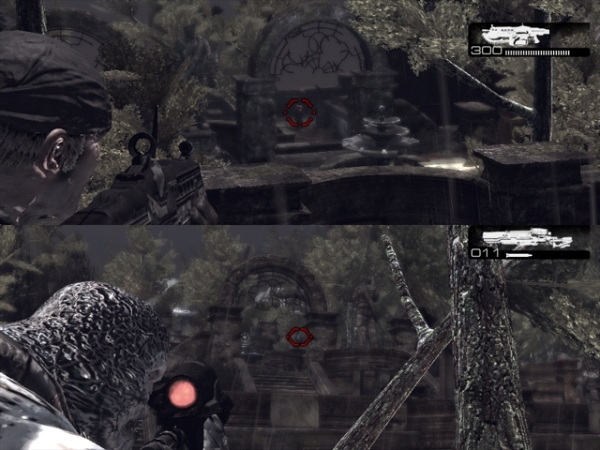Gears of War
Friday 16th November 2007
Are you looking for the latest events and promotions for Gears of War®? Look no further! You can always find upcoming Gears of War events on our new Promotions and Events page!
Gears of War: Understanding the Game
We’re excited about the community’s interest in making multiplayer maps for Gears of War, once the editor becomes available. We thought we’d share what we’ve found does and doesn’t work when designing multiplayer maps for Gears of War. This isn’t a technical “how to use Unreal Ed” doc, but rather a high-level design doc specifically for Gears multiplayer maps.
We weren’t even sure if we were going to include multiplayer in Gears, simply because it is very easy to make a bad Gears map, and it took us a long time to figure out the “rules” that make multiplayer maps worth playing. We don’t want the community to have to reinvent the wheel, and hopefully this doc will save both designers and players from a bunch of frustration.
Every “rule” below can be (and has been) broken, and indeed doing so will often create something interesting or unique. Just keep the basics in mind and decide consciously to go outside the lines rather than stumbling blindly ahead. I would caution you not to disregard more than one or two of these in a given map until you understand the repercussions of the various facets discussed below. The fun factor of a Gears map can be a house of cards, so be careful when you bump it!
So without further ado, here they are in no particular order:
THE “FRONT”
The most important gameplay factors in Gears are the narrow field of view and restricted rotation rates. It’s like being inside the Batman suit from the original Tim Burton movie. While technically limiting to the player, this is also a major reason why Gears feels intimate, as it allows the enemy on screen to be substantially larger and more visible, and it generates tension and vulnerability.
With this in mind, it becomes very important that both teams have a “front” or common direction an enemy is likely to come from. Players need to be able to line up on some cover with their squad and concentrate fire. A random, sprawling arena with no clear directional structures allows enemies to come from any direction, and the use of cover becomes a burden instead of a benefit because it generally only works in one direction.
Since the player is essentially looking through a cardboard tube, they need to know where to look, because scanning the environment is difficult and will blow the pacing of your map.
The shapes and positioning of your cover can play a big part when you’re defining a front. Set up obvious defense areas and give them an orientation that makes their intended use clear to anyone who sees it. Use walls or impassable areas to funnel players through the regions you've defined as combat areas.

Escalation immediately orients the player.
A clear example of this is the map “Escalation,” where teams start at the top and bottom of a giant linear staircase. From either spawn position, the player immediately knows which direction the threat will be approaching from. There’s room for lateral movement and flanking along the front, but the general orientation is always there.
THE “VISIBLE FLANK”
The Holy Grail moments we look for in Gears playtest sessions come when a flanking maneuver happens intentionally, it’s earned fairly, and it’s effective and rewarding to execute. The player’s visibility as discussed above plays a huge role in making this happen, especially the bit about being “fair” rather than random. When players die, they should feel that it was through a decision of their own making and not the designer’s cheap trick or oversight. Players are just fine with dying if they learn from their experience, or if it was a result of smart play by opponents, but not if they feel like a victim.
Picture a level made of many tight rooms all connected with random doors. This is a breeding ground for what is absolutely the most frustrating scenario for your players. You’re in cover engaged with an enemy, and out of nowhere someone steps out of the doorway behind you and blasts you with the shotgun point-blank. You didn’t have a chance to see him coming, you didn’t have a chance to react, and the weapon’s lethality means that you have little chance of surviving. You were a victim of a random car crash and your decision-making had little to do with the outcome. You’ll giggle about this once if you’re the guy with the shotgun, but the guy you shot will most likely never play your map again, or possibly never play Gears again (choosing instead to spend his time ranting about how overpowered the shotgun is). Do us a favor and avoid this, will ya?
But how do you avoid this? If you take nothing else from this document, take this: Players who are paying attention should always have a chance to see an enemy attempting to flank them, and have a chance to react. Instead of using standard walls for most of your level’s structure, consider using low impassable areas or crevices, or at least put many gaps in your walls to allow an observant player a chance to see what’s going on in the next area.
Flanking someone should involve more than a split second roadie run or evasion to the side, it should be a deliberate action and ideally require a bit of risk or exposure to pull off (picture a high-ground flanking area, but with little cover or no good escape route).

Gridlock provides an abundance of low cover.
Next Page 1|2|3 Last Page
- More Gears
- Xbox.com
- Gearsofwar.com
- Gamefaqs.com
- Shop
- Amazon.com
- Gamestop.com